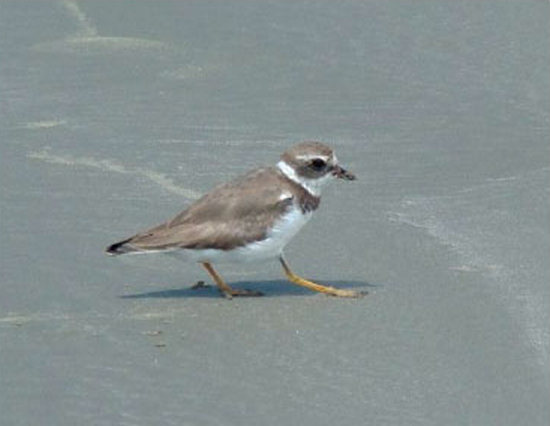Foot-trembling involves a bird holding one of its legs forward and tapping it rapidly on the ground. It is a foraging behaviour used in damp habitats, often on fine sandy beaches in intertidal zones. The vibrations are thought to cause invertebrates hidden below the surface to start moving, so that they can be detected by the bird.
This glossary item highlights the results of two Open Access papers, both about foot-trembling, one from Scotland and one from Brazil. The first is by BC Osborne, published in Bird Study in 1982, and called Foot-trembling and feeding behaviour in the Ringed Plover Charadrius hiaticula. The critical observations, made in winter 1975/76, are described like this: “Not easily noticed at first, foot-trembling becomes more obvious once the characteristic ‘trembling pose’ of the bird is recognised. While engaged in foot-trembling, Ringed Plovers remain stationary, standing on one leg with the trembling leg extended forward to the substrate. The trembling is at a surprisingly high frequency, in the region of 10 cycles per second (estimated from direct observations and analysis of cine film) with a very small amplitude (approximately 2 mm). Bouts of trembling last for several seconds and are interrupted by attempts to capture prey or occasionally by local movements to a new patch of substrate, presumably in response to a reduction in prey capture rate on the original patch. Ringed Plovers were observed foot-trembling only in a shallow inlet near the high tide mark.”
Another interesting paper, authored by César Cestari in 2009, is called Foot-trembling behavior in Semipalmated Plover Charadrius semipalmatus reveals prey on surface of Brazilian beaches. This Open Access paper contains a list of the plovers and lapwings that employ the technique, and a valuable list of references. More observations of foot-trembling have been made in New Zealand than in any other part of the world.
César Cestari described what he observed on beaches in Brazil. His focus was on Semipalmated Plovers Charadrius semitorquatus. He noted that they ran forward, and then “individuals would stop and hold one of the tarsi forward at an angle of approximately 45º and then vibrated the foot and tarsus rapidly. … Generally, individuals pecked the surface within a distance of 2-7 cm in front of the location where they performed the foot-trembling in order to capture prey.”

None of the observations of foot-trembling in plovers and lapwings has been made in Africa. If you observe this, please write a short note for Biodiversity Observations.
The only species on César Cestari’s list that is not a plover or a lapwing is the Snowy Egret Egretta thula; this egret was reported foot-trembling in 1948. This American species has yellow feet, like the Little Egret Egretta garzetta and the Black Heron Egretta ardesiaca in Africa. These are maybe two African species to watch closely for using movement of the feet to forage. There must be some use for having yellow feet at the end of black legs!
Read the two Open Access papers referred to here. They contain a variety of ideas and hypotheses about foot-trembling.
